Our Galapagos Islands Adventure: Part 1
Sailing into the Galápagos Islands is both a journey into a realm of extraordinary natural beauty and an immersion in a living laboratory of evolution. As Charles Darwin once wrote, “The natural history of this archipelago is very remarkable: it seems to be a little world within itself.” True to these words, when Bundalong dropped anchor in the safe harbor of Puerto Baquerizo Moreno on the island of San Cristóbal, we were immediately captivated by the islands and their remarkable inhabitants.
We were warmly welcomed by Antonio, our agent from Seamasters Galápagos who helped us clear into Ecuador. Over the following month Antonio would become one our essential Bunda teammates assisting us navigate the islands’ complex rules, regulations, and permits, ensuring Bundalong’s journey around the archipelago was seamless. He also introduced us to Franklin our guide, who would be onboard with us for the whole trip and without whom we could not have had such a life changing experience.
Part 1 of Galapagos blog will recount our first cruise in early January around the central islands, with Part 2 to follow, detailing our exploration of the western island of Isabela.
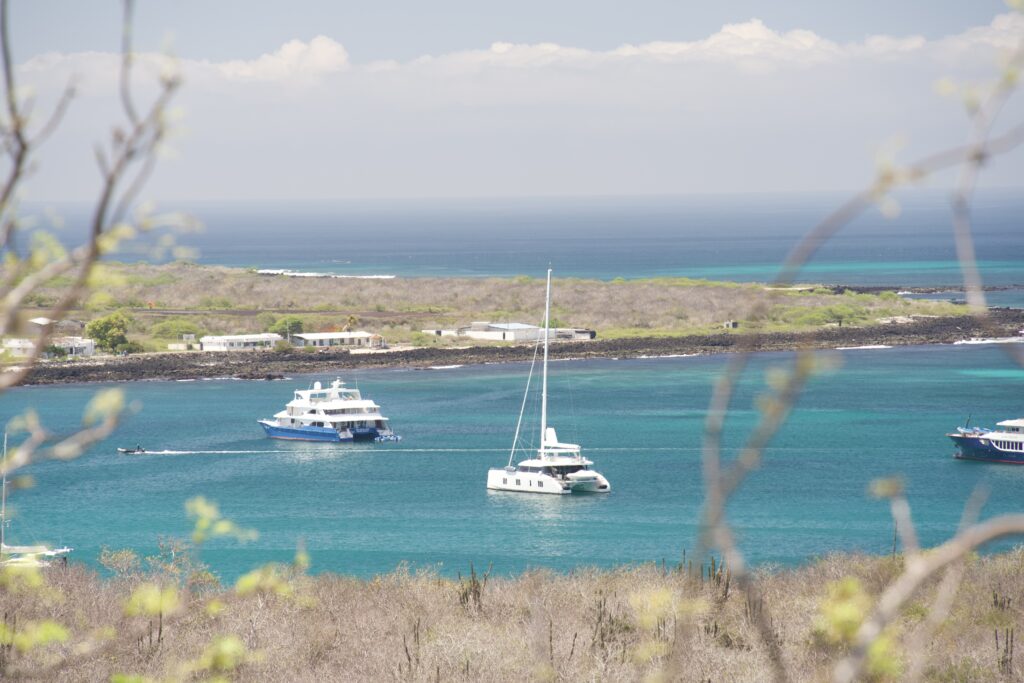
DAY 1: San Cristobal
Our cruise began at San Cristobal, fittingly named after St. Christopher, the patron saint of sailors. It is the fifth largest and easternmost island of Galápagos with a landscape comprised of three to four fused volcanoes, all extinct, home to the oldest permanent settlement of the islands and the island where Darwin first went ashore in 1835.
With guests arriving directly at the little airport, we soon had all onboard, setting sail up the western coast to our first overnight anchorage at Cerro Brujo, where our first Bunda-venture would begin.
DAY 2: Isla Lobos
Mornings in the Galapagos come early and eager guests were ashore by 8.30am to visit the near-perfect white sand beach, littered with the islands’ most notorious inhabitants… sealions. Resembling “a pack of laid-back dogs wearing wetsuits” these creatures would entertain us over the coming weeks, becoming a mainstay of our travels. The Galapagos Sealion, has an estimated population of 20,000, are both endemic and endangered and share the islands with their smaller counterparts, the Galapagos Fur Sealion.
We upped anchor and headed out to Kicker Rock, an emblematic sea monolith, home to numerous sea birds – frigates, boobies and petrels – before continuing south to Isla Lobos for the afternoon and night.
Here we jumped in the cool blue waters for our first snorkel. Isla Lobos is famous for its sealion population and they came out to greet and play with us as we swam along the surface whilst Blue-footed Boobies dived bombed for fish around us.
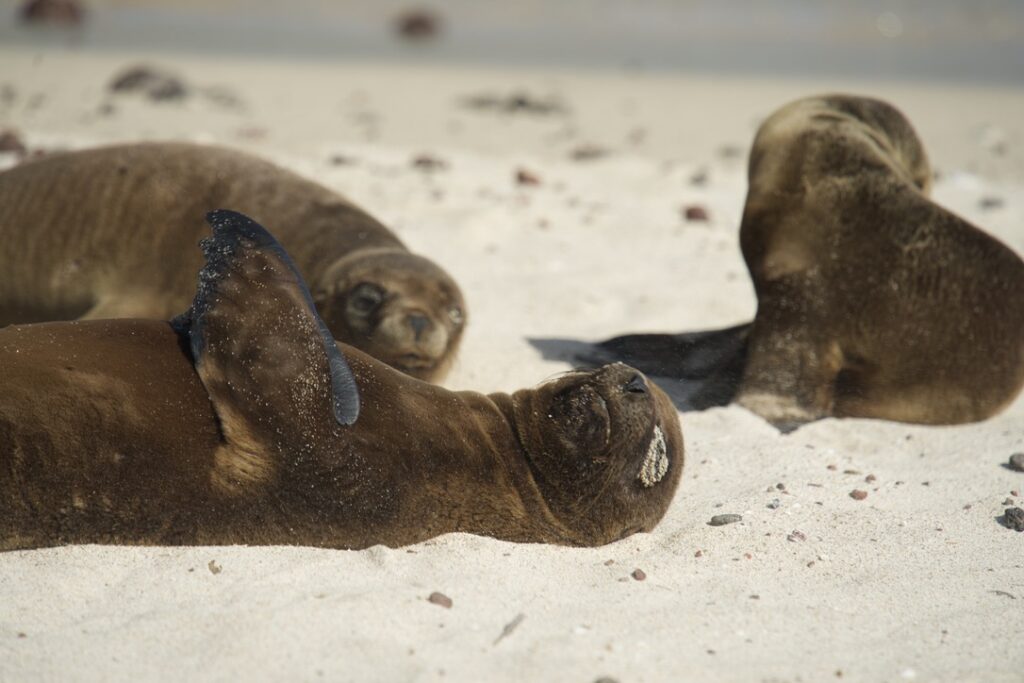
DAY 3: Espanola
A 5am start and a four- hour sail south to Espanola Island, all were up early to enjoy watching sealions playing and keeping watch for Manta Rays.
Española is the southernmost of the Galapagos Islands and is also one of the oldest. Geologists estimate it is about four million years old. Because Española is one of the most isolated islands in Galapagos, it has many endemic species including the Española mockingbird and the Española lava lizard, both of which greeted us as we landed at Gardner Bay. We stretched our legs, walking along the beautiful white beach, dodging the honks and barks emitted from basking sealions, before returning to Bundalong and traveling down the coast to Suarez Point.
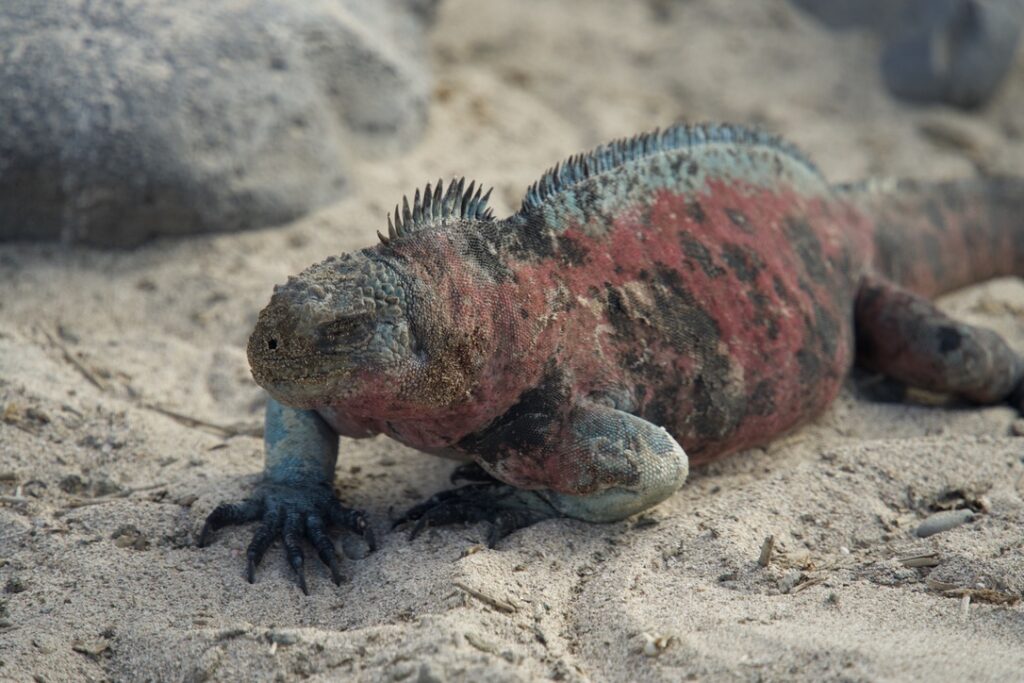

Suarez Point is one of the Galapagos’ most wildlife-rich locations, and it certainly lived up to its reputation. We made our way through a colony of sea lions and witnessed some intense marine iguana battles before heading inland to the Waved Albatross nesting site, the only place in the world where this species breeds. Although we were visiting late in the season, we still spotted a few young albatrosses, and we sat on the cliffs, watching them practice flying by hopping and stretching their wings. Then, by chance, one of the albatrosses took its first flight, soaring off the cliff and heading out into the ocean, not to return for another four years. It was an unforgettable moment and one of the highlights of our trip.
Our walk continued through the island’s Nazca Booby population, who squawked half-heartedly at us, tolerating our presence. Countless marine iguanas huddled up to one another for warmth in the late afternoon sun whilst lava lizards tried to trip us up with their fast scurrying across the rocks. The island certainly teemed with life, most of us having never encountered such a place like it before and it was a wonderfully enriching experience.
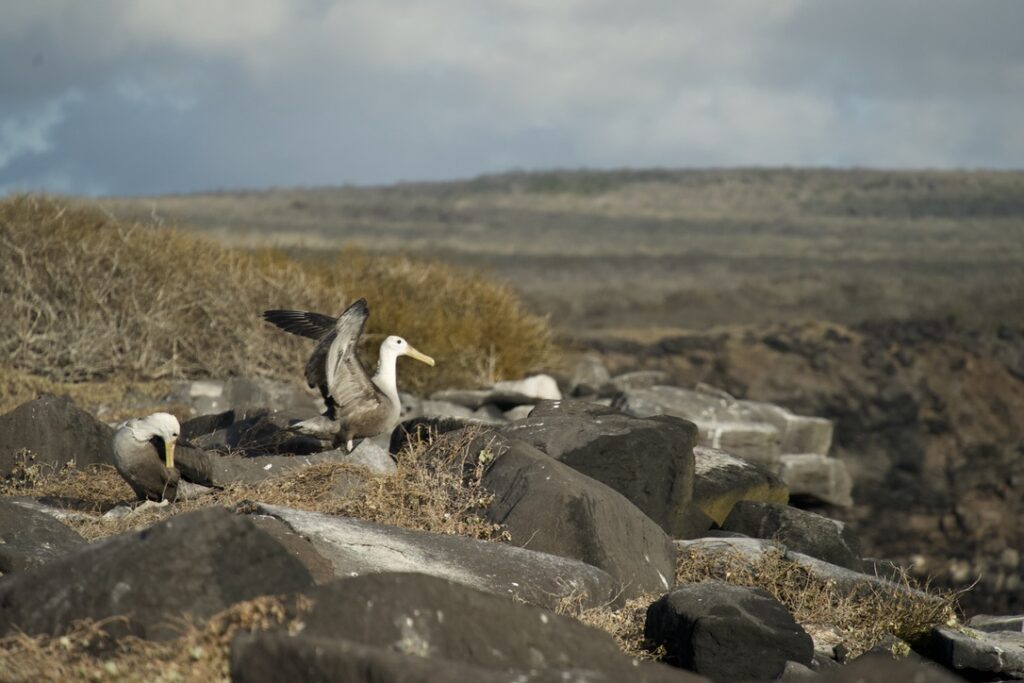
DAY 4:
Our morning sail headed us northwest to Santa Fe. Santa Fe Island, also called Barrington Island after British Admiral Samuel Barrington, is a small, relatively flat island at the center of the archipelago. Santa Fe is home to two species endemic to the island: the Santa Fe Rice Rat and the Santa Fe Land Iguana. The land iguana population was recently estimated to have 6,500-7,000 individuals and the island is also home to the longest research project on marine iguanas, begun in the late 1970s. We headed ashore and encountered the very strange tree-like Opuntia Cacti – endemic to the Galapagos and producing a flavorful fruit that the Santa Fe Land iguana feeds on. These uniquely yellow iguanas posed for photos with a perma-smile etched on their faces – who wouldn’t when they lived here?!
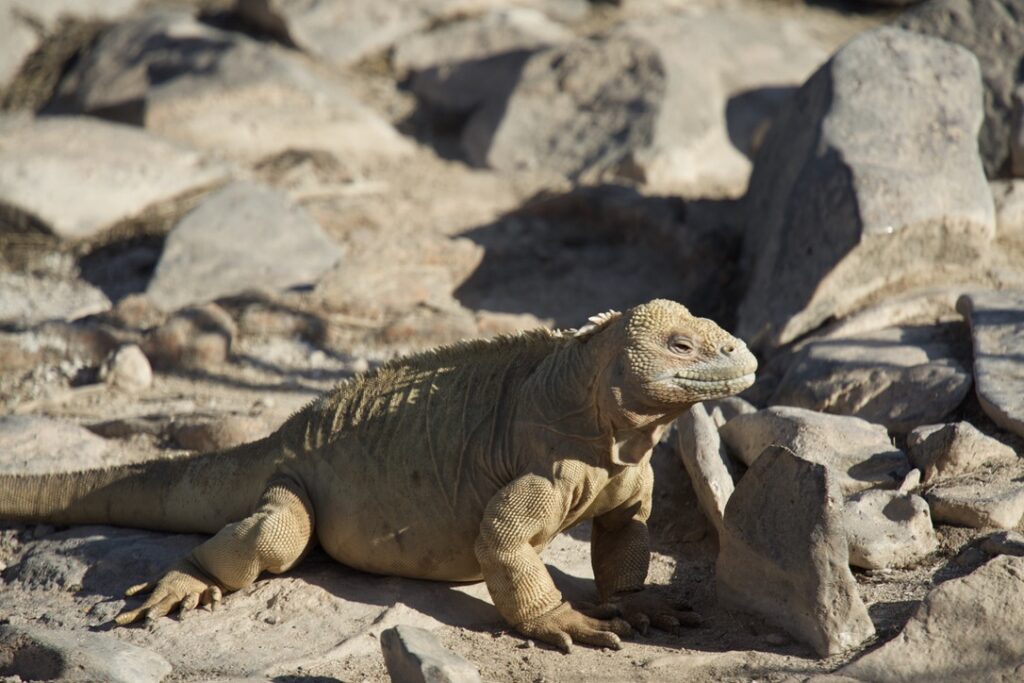
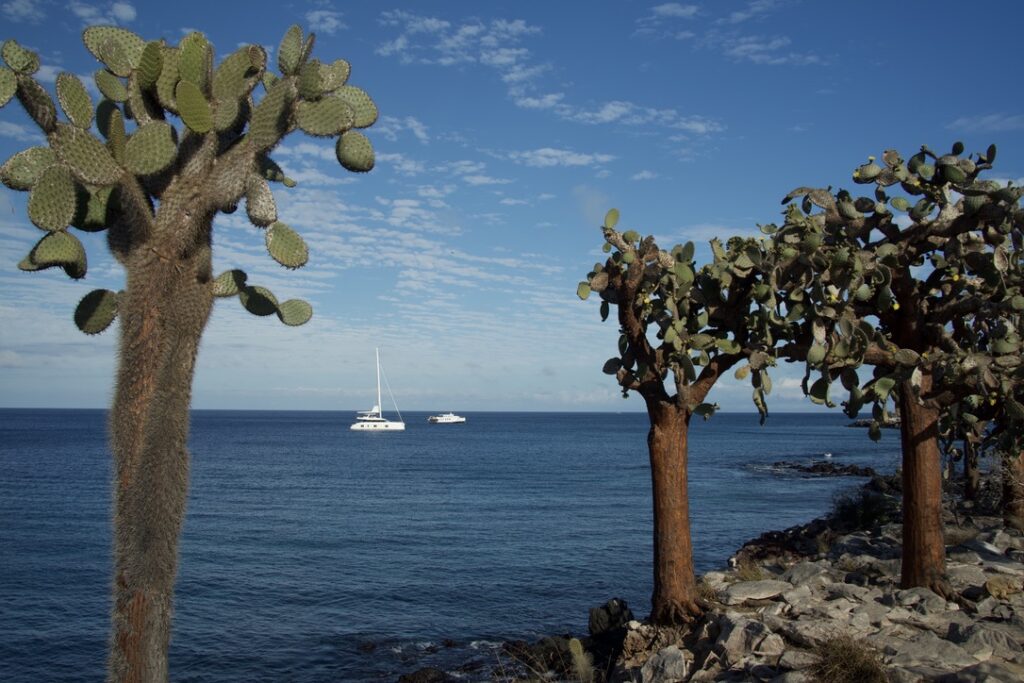
DAY 5: South Plazas and Gordon Rocks
Sailing on to the South Plazas, here the group split and half of us headed ashore for a hike, the others headed to Gordon Rocks for the first dives of our trips.
A short, 5-minute boat ride past South Plaza and out to the rock pinnacles that make up the dive site otherwise known as ‘the washing machine,’ Gordon Rocks can be a high-current, technical dive. Today the currents and visibility were in our favour and we spent 45 minutes diving past the great pinnacles that make the site so famous. The 5mm wetsuit was welcomed in the cool swirling gin-like thermoclines that attracted large pelagics, such as mobula rays, tuna and the rather formidable looking Galapagos shark, whereas patches of warm current pushed through and with it turtles and hammerheads passed by.
DAY 6: North Seymour
Named after the English nobleman Lord Hugh Seymour, North Seymour was formed by a series of uplifts of submarine lava along with Baltra and the northeastern part of Santa Cruz, resulting in flat plateaus. North Seymour is now home to nearly 2,500 land iguanas. This island also hosts large populations of blue-footed boobies, swallow-tailed gulls, common noddies, and frigatebirds. We hiked ashore to see the birds, notably the population of frigate birds with their red-chests puffed out in mating stance, impressive to the females – and us!
Diving again today, this time at Mosquera Islet and the channel at North Seymour, both of which will be etched in the minds of those who went.
Our first dive at Mosquera was warm – very warm – which means one thing in the Galapagos – Hammerheads. And they did not disappoint us. We were soon surrounded by a school of 40 or so, casually gliding through the water – what a sight! To follow were Galapagos sharks, turtles, eagle rays, mobula rays, bumphead parrot fish… it was a conveyor-belt of checklisted ‘must-see’ sea-creatures, one after the other. The divers, doing little underwater dances on each new encounter, shouted wordless whoops of joy that escaped as great bursts of bubbles from regulators, all lost in childlike wonder – this was a once in a lifetime 10/10 dive!
After breath was gathered and fruit and local guacamole consumed for sustenance, we had one more dive, this time a drift through the channel at North Seymor. Once again, the Galapagos lived up to its reputation and as we whizzed by underwater, we were joined by sealions, playing, swooping, speeding past us whilst white tip sharks slept in vast numbers on the sea floor below.
What an incredible day!
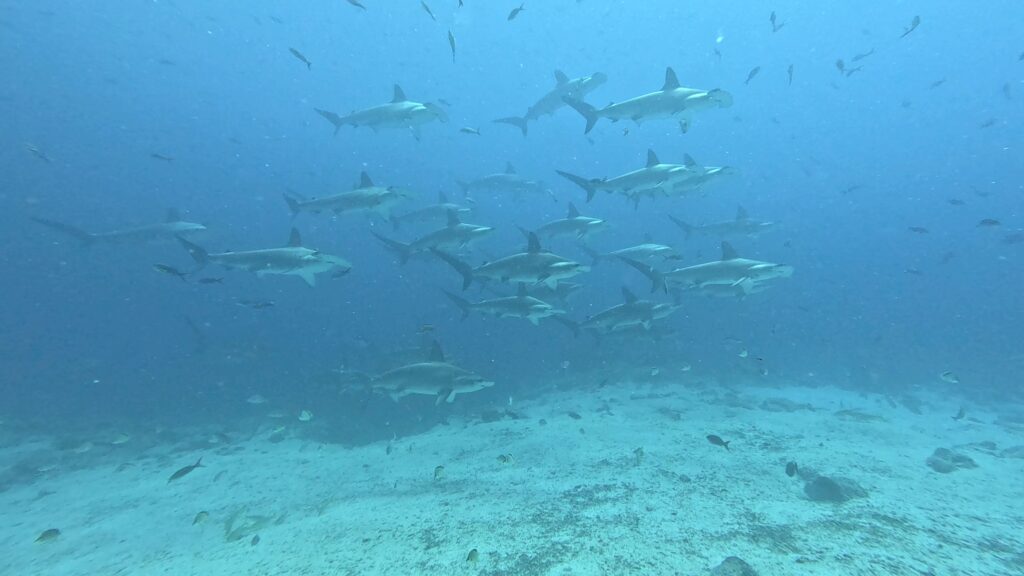
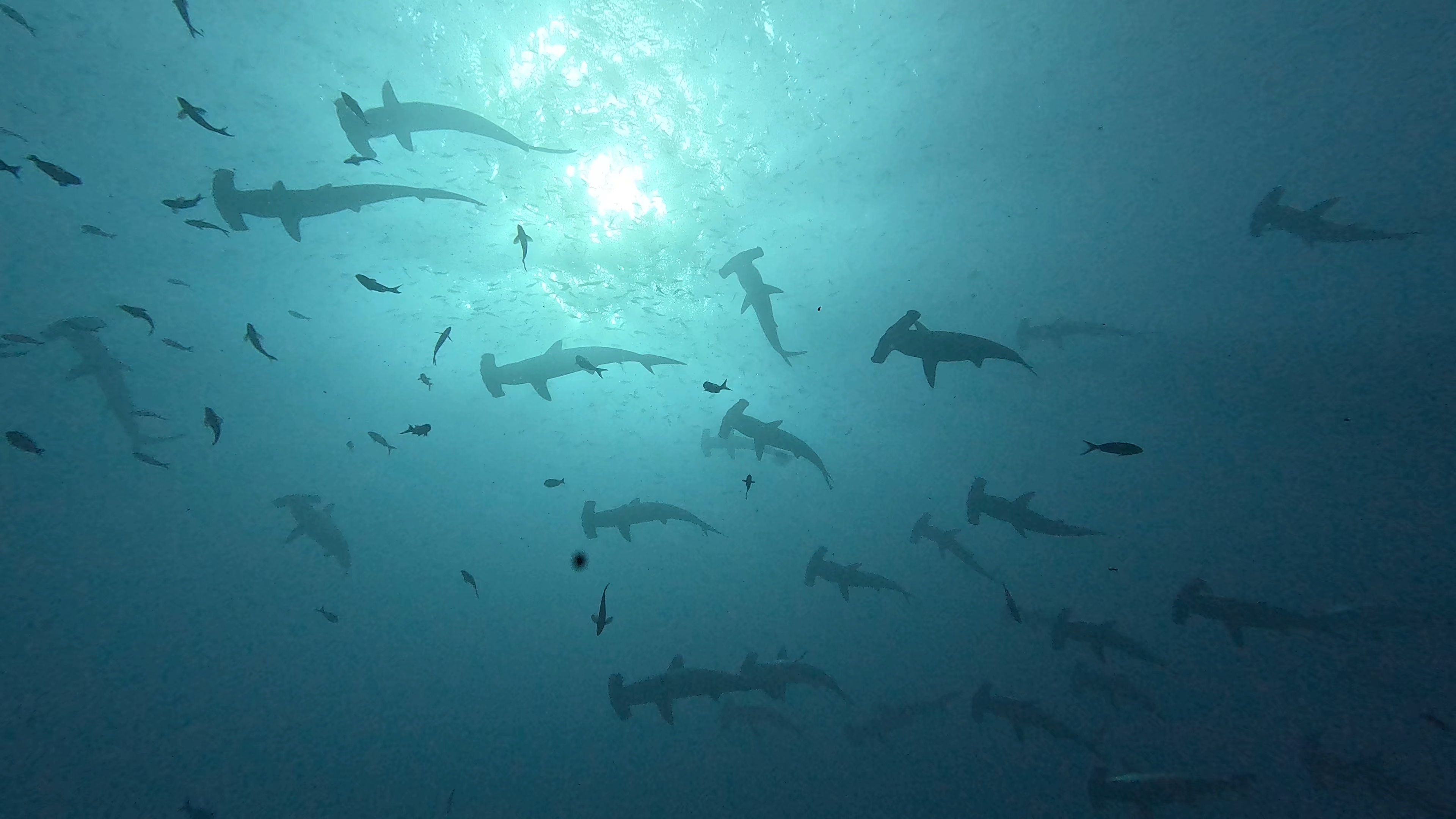
DAY 7: BARTOLOME
We departed North Seymour and enjoyed a 2-hour sail east to the island of Santiago and our anchorage for the day at Sullivan Bay. This iconic bay is covered in black ropey pahoehoe lava which gave a metallic ring to it when we walked along the rocky shores, whilst clusters of vegetation poked through the sandy beaches.
Trying our luck, we snorkeled in the bay in the hope of catching a glance of the Galapagos Penguin underwater. Endemic to the islands, they are the most northern living penguin the world (with a small nesting group north of the equator on Isabela island!) Small and agile these underwater bullets shot past us, most of the time without us realizing it until too late! We couldn’t miss the sharks or rays though – another amazing day in the water!
The divers also had another good day out at Cousins Rocks, another pinnacle, this time with a glorious wall of soft corals, with large pelagics, schooling barracudas and bringing a range of fish otherwise unknown to most of us.
As the afternoon suns’ started to fade team Bunda hiked up the extinct volcano of Bartolome to watch the sun set over the lava fields and to the peaks of Santiago and Chinese Hat island. A barren landscape, inexplicably home to so much extraordinary life.
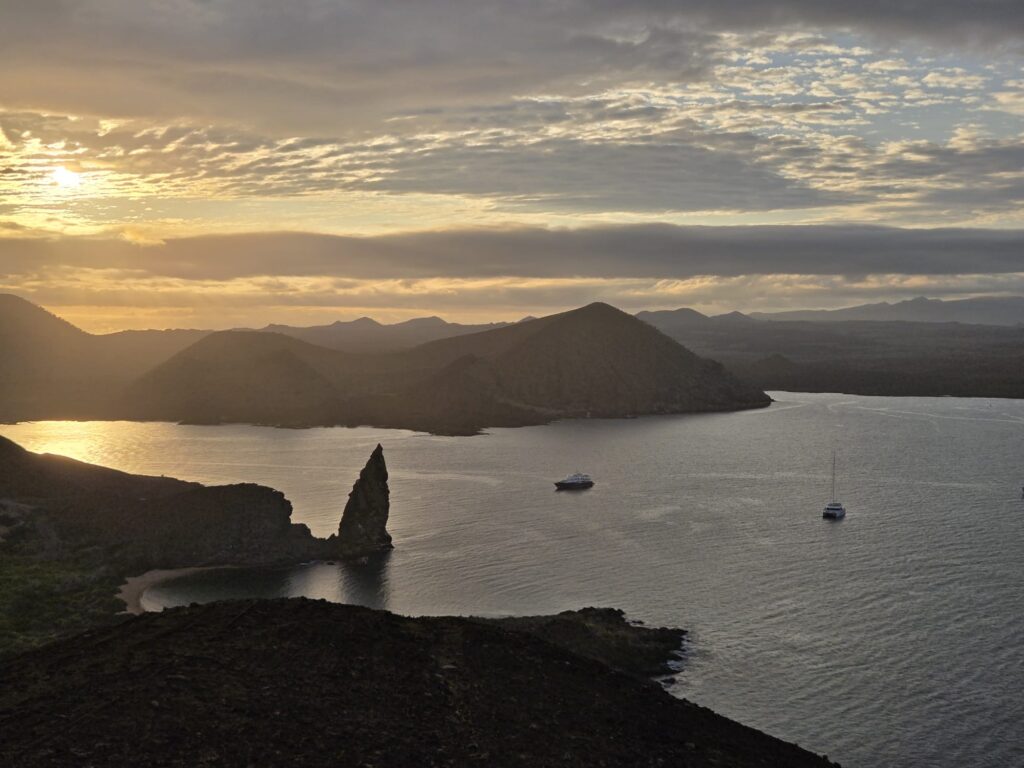
DAY 8: BUCCANEER COVE and PUERTO EGAS
We set sail for Puerto Egas on the western coast of Santiago, sailing along its northern shores and stopping for a quick tender ride at Buccaneer cove. From the 1600s this sheltered anchorage was used by whalers, privateers, pirates, and buccaneers as a staging point for water, wood and meat. The easy-to-catch giant tortoises provided a useful source of protein for the sailors – Darwin observed in his Voyage of the Beagle that while hiking in the highlands, he and his colleagues “lived entirely upon tortoise-meat: the breast-plate roasted (as the Gauchos do carne con cuero), with the flesh on it, is very good; and the young tortoises make excellent soup.”
Somberly reflecting how different the Galapagos may have become had it not been turned into a national park in 1959 we headed further down the coast to the idyllic anchorage of Puerto Egas.
We hiked ashore and learnt that it had been the site of a salt mine many years previously, however, few signs of humanity remained and mockingbirds chirruped us merrily along our way as we passed by the volcanic cone of Pan de Azucar. We made our way out to the opposite shoreline and onto a large lava field which, carved into openings and bridges by the sea and now home to the vivid red Sally Lightfoot crabs, marine iguanas and Galapagos fur sealions. We were amazed at how we could wind our way through such diversity of life and whilst the creatures may take a second to look at us were not scared of humans in any way.
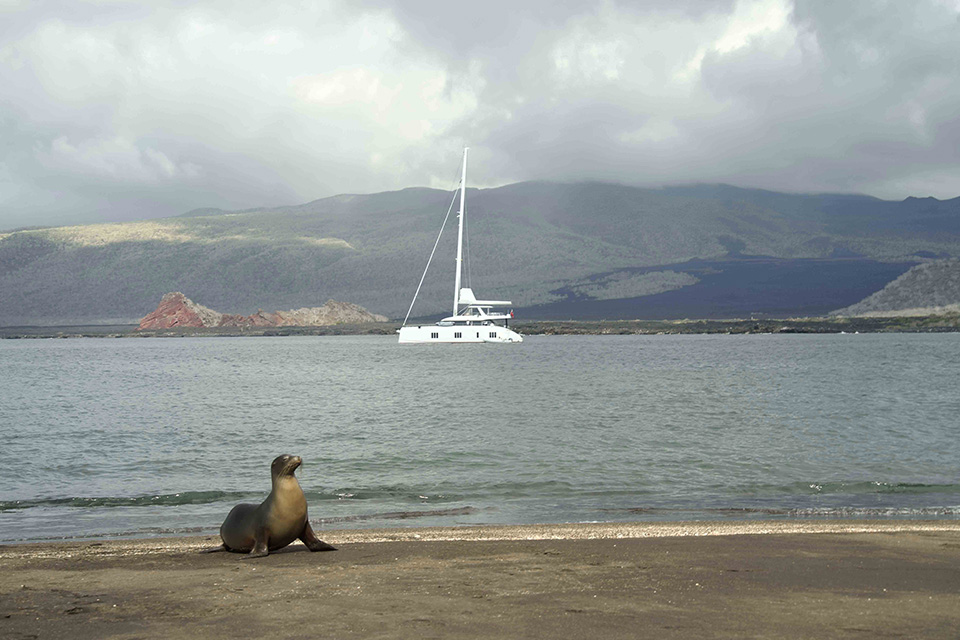
DAY 9: Rabida and Sombrero Chino Islands
Passing around the bottom of Santiago we sailed south to Rabida Island, a volcanically diverse island with magnificent red cliffs and beach, unique to the Galapagos and due to the high iron content in the ancient lava. We stopped for a quick walk along the beach and a foray into the greener interior, which was home to flamingos! How does the Galapagos keep giving us such extraordinary feasts for the eyes?
In the afternoon we headed to Chinese Hat Island – or Sombrero Chino – so named due to its symmetrical volcanic cone that looks like a traditional Chinese hat. Here the landscape was rugged and wild, barren and hot ashore. A snorkel cooled us down and again we found ourselves in a world of sharks, rays, colourful fish – and this time penguins that came to play!

DAY 10: Santa Cruz
A leisurely sail to Santa Cruz with the wind in our favour, team Bunda were on the lookout once more for Manta Rays, jumping in the early morning sun.. and of course our ever-present friends, sealions.
We anchored at northern side of Santa Cruz, where we went ashore and drove into the green and cool highland interior of the island to see our final Galapagos ‘must-see’… the Giant Tortoise!
With an endangered population, the tortoise has been brough back from the brink of extinction, long gone are the days where you could ride the back of a tortoise (including Darwin!) or carry one away for a handy to-go meal on your ship (it’s estimated some 200,000 tortoises ended up on the dinner plates of sailors.) Now either in breeding programs or roaming free, these mighty creatures, that have withstood the passing of time, were a sight to behold.
After a shopping stop in Puerto Ayora for some local souvenirs, we headed back to the boat, did a quick costume change, then headed out once more to the highlands for the evening. This time, to the Royal Palms Lava Tunnel Restaurant. We drove through lush, rain-soaked forest on rugged dirt roads, eventually arriving at the entrance to the lava tunnel. Armed with a helmet and a torch, we descended a ladder and ventured 400 meters through softly lit volcanic passages to a one-of-a-kind dining experience. Inside the atmospheric lava cave, we enjoyed a 5-course degustation, taking our taste buds on a journey across Ecuador, from the mountains to the sea. What an unforgettable night!
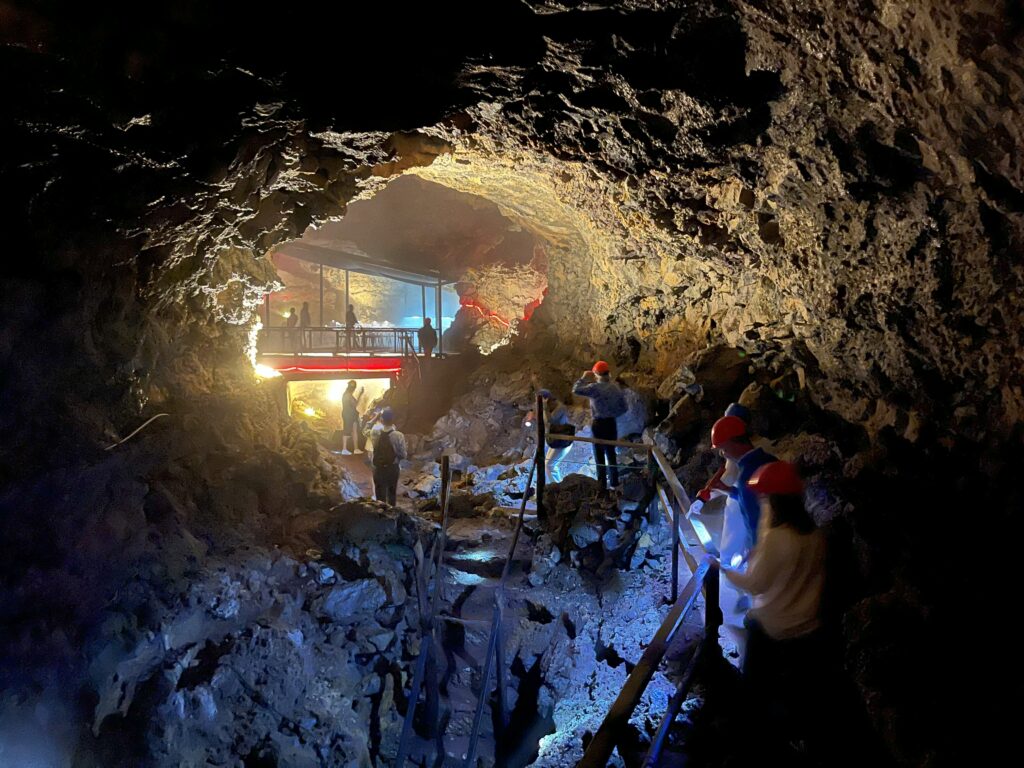
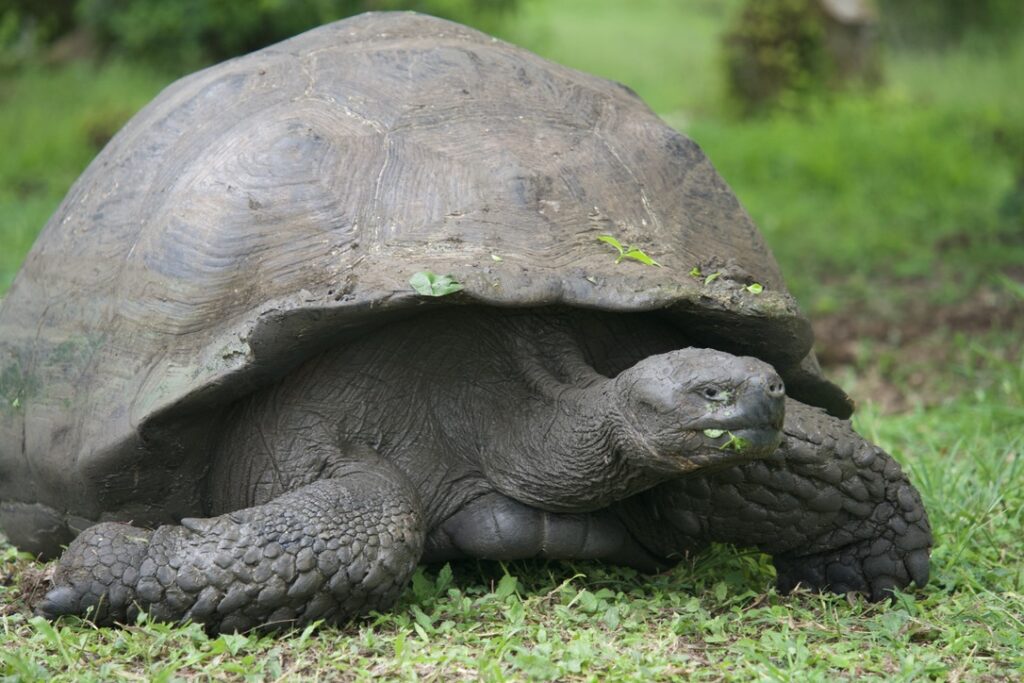
DAY 11: Bachas Beach and Black Turtle Cove
Our last morning of activities and for once a slightly later start! We headed to Bachas beach, one of the five most important nesting areas for green sea turtles in the Galapagos. Not our time to see them, but we managed a few more flamingos and the usual suspects of sealions and iguanas.
In the afternoon we took a tender ride into Black Turtle Cove, a marine sanctuary where in the very shallow green waters of the mangroves we found ourselves surrounded by large schools of golden rays, eagle rays, baby sharks and tons of green sea turtles either mating or sleeping in shallow water. What a way to end things!
DAY 12:
Always a sad day when we have to say farewell to our fellow team Bunda guests. A leisurely brunch, goodbyes and one last tender ride to Baltra Airport and Bundalong was quiet once more.
Our time in the Galapagos, however, was not quite over, and we would be exploring further afield in our final cruise – so stay tuned for Our Galapagos Adventure: Part 2!
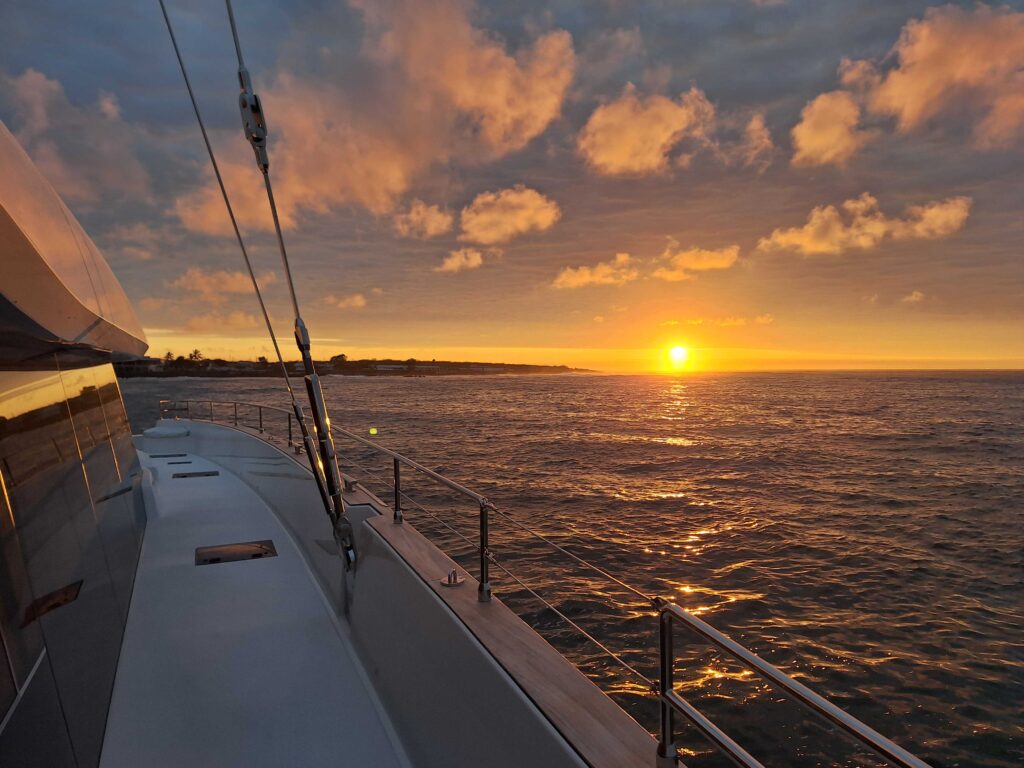


[…] spent the past two weeks cruising the inner islands of the Galapagos, click here for Part 1, we were amped to pick up our guests and start voyaging anew, heading further afield this time and […]